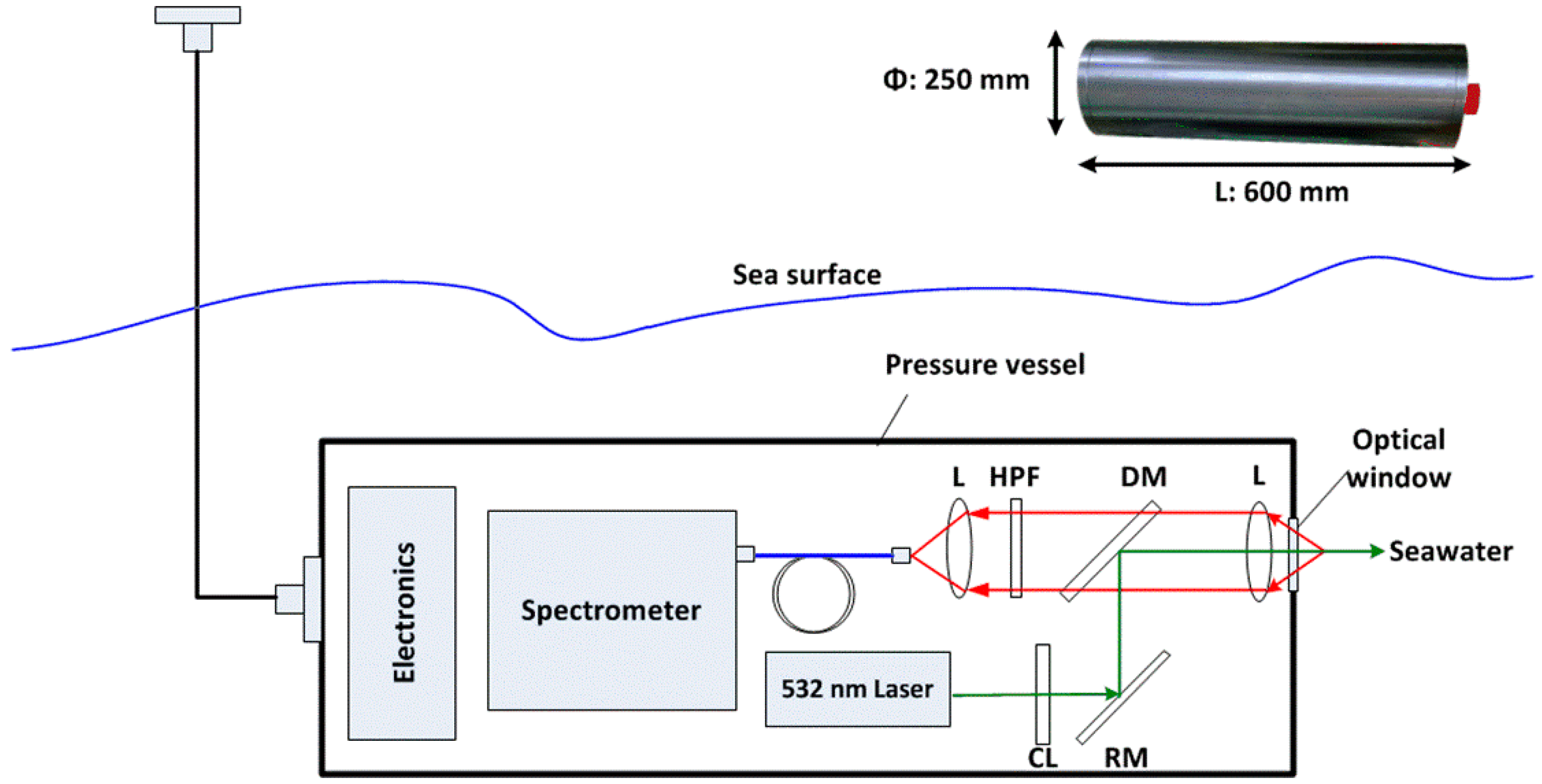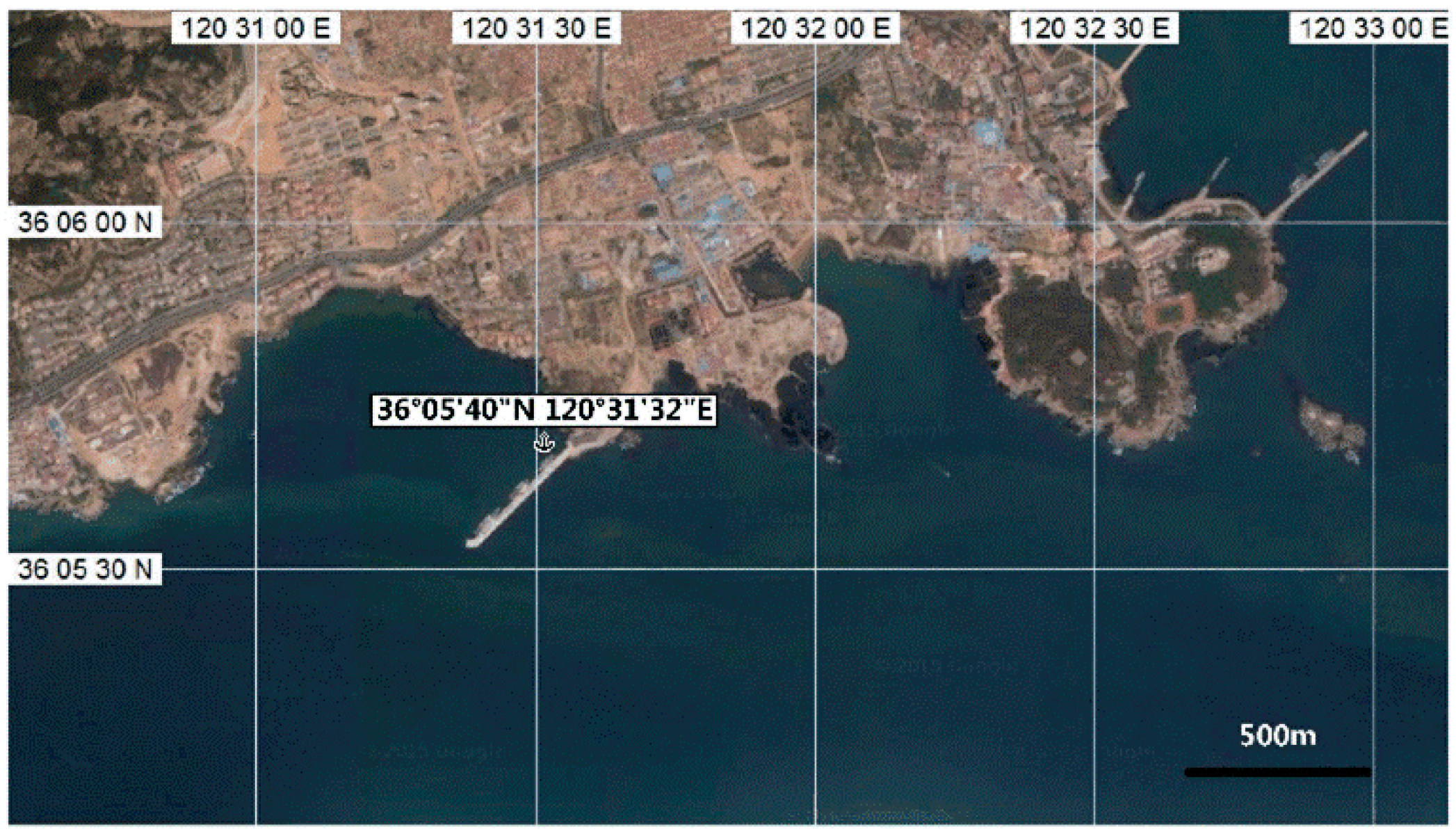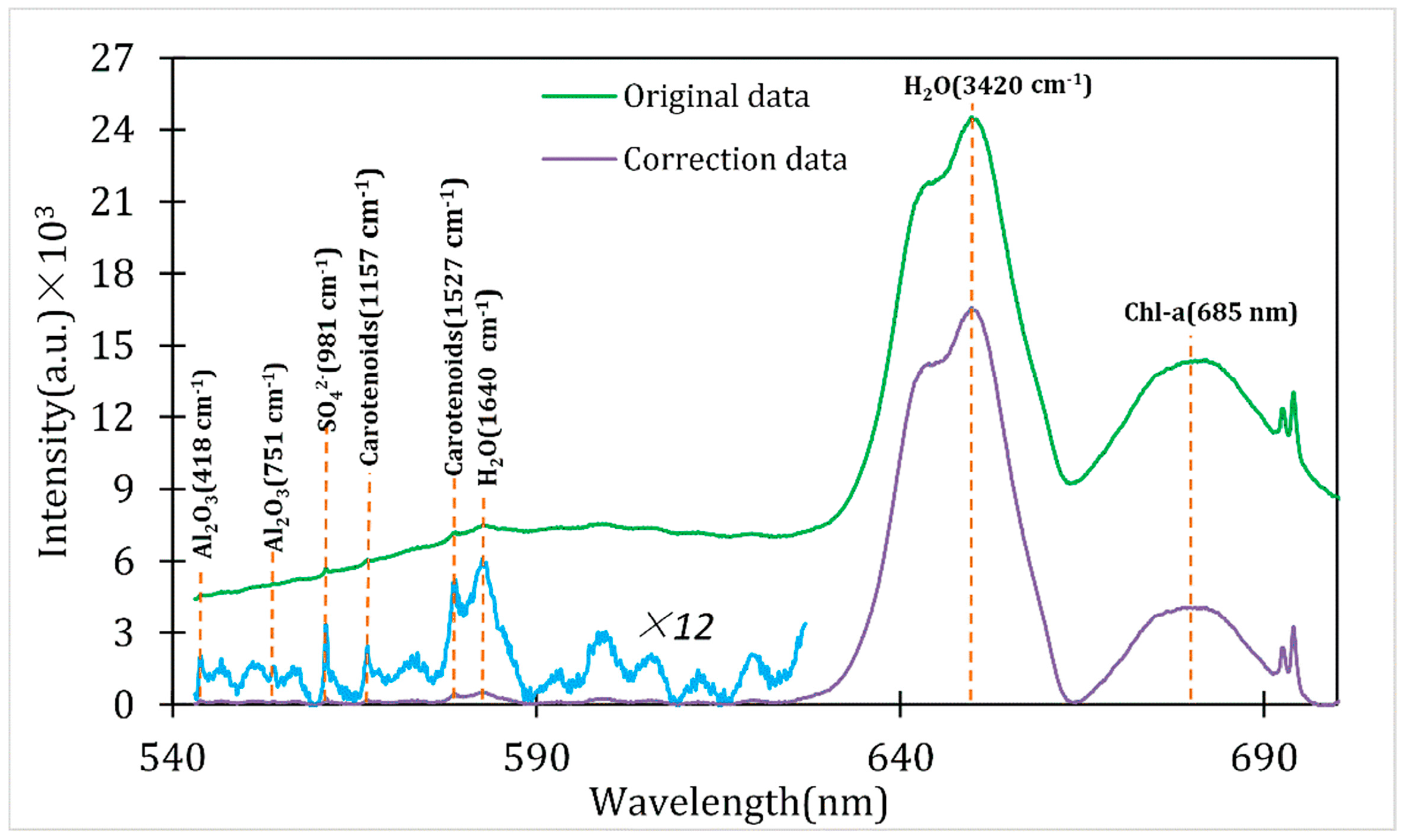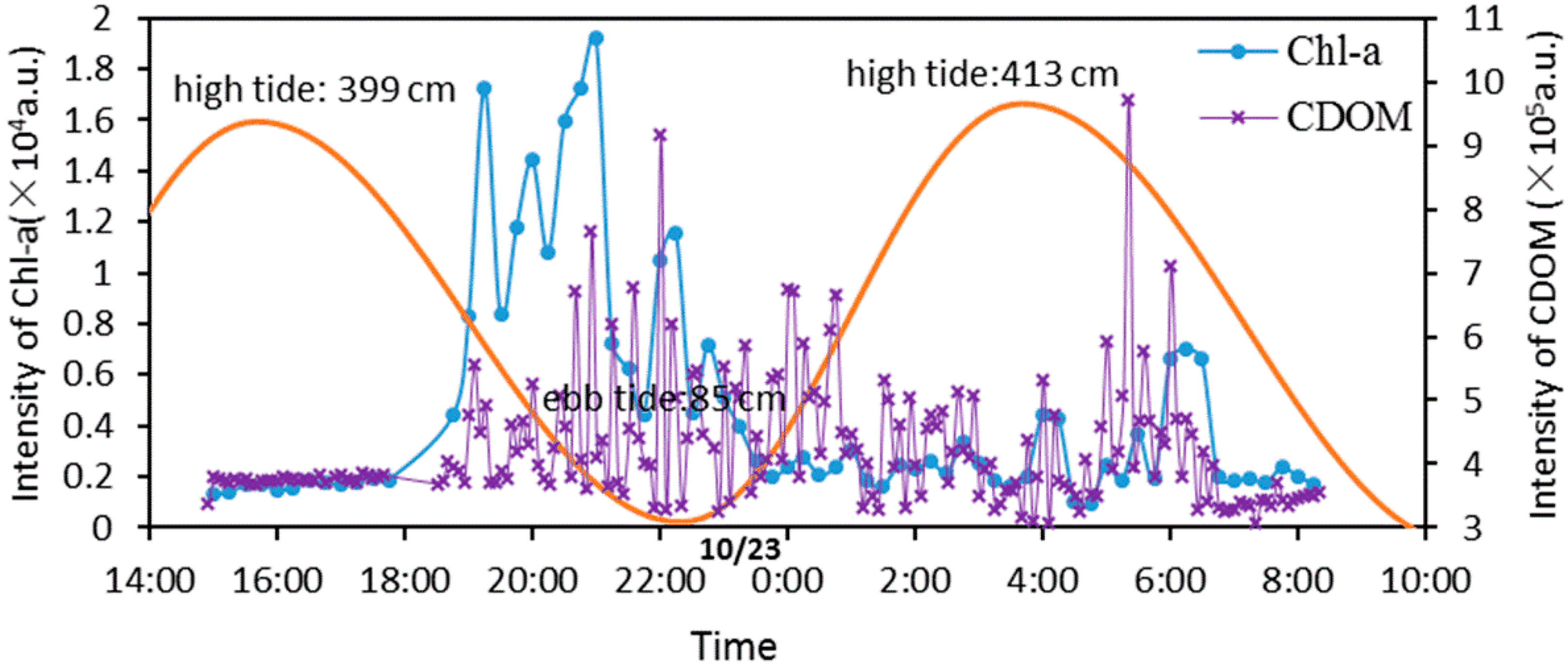Diurnal Variability in Chlorophyll-a, Carotenoids, CDOM and SO42− Intensity of Offshore Seawater Detected by an Underwater Fluorescence-Raman Spectral System
Abstract
:1. Introduction
2. Instruments and Experiments
2.1. Instrument Setup
2.2. Experiment In Situ
2.3. Method of Data Processing
3. Results and Discussion
3.1. The Typical Spectra
3.2. Diurnal Variation of Chl-a and CDOM
3.3. Diurnal Variation of Carotenoids
3.4. Temporal Change of CDOM and SO42−
4. Conclusions
Acknowledgments
Author Contributions
Conflicts of Interest
References
- Hay, M.E. Marine chemical ecology: Chemical signals and cues structure marine populations, communities, and ecosystems. Annu. Rev. Mar. Sci. 2009, 1, 193–212. [Google Scholar] [CrossRef] [PubMed]
- Boyle, E.A. Introduction: Chemical Oceanography. Chem. Rev. 2007, 107, 305–307. [Google Scholar] [CrossRef]
- Puglisi, M.P.; Sneed, J.M.; Sharp, K.H.; Ritson-Williams, R.; Paul, V.J. Marine chemical ecology in benthic environments. Nat. Prod. Rep. 2014, 31, 1510–1553. [Google Scholar] [CrossRef] [PubMed]
- Schagerl, M.; Müller, B. Acclimation of chlorophyll a and carotenoid levels to different irradiances in four freshwater cyanobacteria. J. Plant Physiol. 2006, 163, 709–716. [Google Scholar] [CrossRef] [PubMed]
- Higgins, H.W.; Wright, S.W.; Schluter, L. Quantitative interpretation of chemotaxonomic pigment data. In Phytoplankton Pigments: Characterization, Chemotaxonomy and Applications in Oceanography; Cambridge University Press: Cambridge, UK, 2011; pp. 257–301. [Google Scholar]
- Wright, S.W.; Jeffrey, S.W. Pigment Markers for Phytoplankton Production; Springer: Berlin, Germany; Heidelberg, Germany, 2006; pp. 71–104. [Google Scholar]
- Stedmon, C.A.; Markager, S.; Bro, R. Tracing dissolved organic matter in aquatic environments using a new approach to fluorescence spectroscopy. Mar. Chem. 2003, 82, 239–254. [Google Scholar] [CrossRef]
- Zhang, Y.; van Dijk, M.A.; Liu, M.; Zhu, G.; Qin, B. The contribution of phytoplankton degradation to chromophoric dissolved organic matter (CDOM) in eutrophic shallow lakes: Field and experimental evidence. Water Res. 2009, 43, 4685–4697. [Google Scholar] [CrossRef] [PubMed]
- Adams, P.J.; Seinfeld, J.H.; Koch, D.M. Global concentrations of tropospheric sulfate, nitrate, and ammonium aerosol simulated in a general circulation model. J. Geophys. Res. Atmos. 1999, 104, 13791–13823. [Google Scholar] [CrossRef]
- Gaston, C.J.; Furutani, H.; Guazzotti, S.A.; Coffee, K.R.; Jung, J.; Uematsu, M.; Prather, K.A. Direct Night-Time Ejection of Particle-Phase Reduced Biogenic Sulfur Compounds from the Ocean to the Atmosphere. Environ. Sci. Technol. 2015, 49, 4861–4867. [Google Scholar] [CrossRef] [PubMed]
- Dunbabin, M.; Marques, L. Robots for environmental monitoring: Significant advancements and applications. Robot. Autom. Mag. 2012, 19, 24–39. [Google Scholar] [CrossRef]
- Moore, T.S.; Mullaugh, K.M.; Holyoke, R.R.; Madison, A.S.; Yücel, M.; Luther, G.W., III. Marine chemical technology and sensors for marine waters: Potentials and limits. Annu. Rev. Mar. Sci. 2009, 1, 91–115. [Google Scholar] [CrossRef] [PubMed]
- Buffle, J.; Horvai, G. In Situ Monitoring of AQUATIC Systems: Chemical Analysis and Speciation; Wiley: New York, NY, USA, 2000; pp. 50–84. [Google Scholar]
- Pasteris, J.D.; Wopenka, B.; Freeman, J.J.; Brewer, P.G.; White, S.N.; Peltzer, E.T.; Malby, G.E. Raman spectroscopy in the deep ocean: Successes and challenges. Appl. Spectrosc. 2004, 58, 195A–208A. [Google Scholar] [CrossRef] [PubMed]
- Paull, C.K.; Lorenson, T.D.; Dickens, G.; Borowski, W.S.; Ussler, W.; Kvenvolden, K. Comparisons of in situ and core gas measurements in ODP Leg 164 bore holes. Ann. N. Y. Acad. Sci. 2000, 912, 23–31. [Google Scholar] [CrossRef]
- Coble, P.G. Marine optical biogeochemistry: The chemistry of ocean color. Chem. Rev. 2007, 107, 402–418. [Google Scholar] [CrossRef] [PubMed]
- Prien, R.D. The future of chemical in situ sensors. Mar. Chem. 2007, 107, 422–432. [Google Scholar] [CrossRef]
- Wang, X.D.; Wolfbeis, O.S. Fiber-optic chemical sensors and biosensors (2008–2012). Anal. Chem. 2012, 85, 487–508. [Google Scholar] [CrossRef] [PubMed]
- McDonagh, C.; Burke, C.S.; MacCraith, B.D. Optical chemical sensors. Chem. Rev. 2008, 108, 400–422. [Google Scholar] [CrossRef] [PubMed]
- Daly, K.L.; Byrne, R.H.; Dickson, A.G.; Gallager, S.M.; Perry, M.J.; Tivey, M.K. Chemical and biological sensors for time-series research: Current status and new directions. Mar. Technol. Soc. J. 2004, 38, 121–143. [Google Scholar] [CrossRef]
- Amon, R.M.; Budéus, G.; Meon, B. Dissolved organic carbon distribution and origin in the Nordic Seas: Exchanges with the Arctic Ocean and the North Atlantic. J. Geophys. Res. Oceans 2003, 108, 14.1–14.17. [Google Scholar] [CrossRef]
- Gamayunov, E.; Voznesenskiy, S.; Korotenko, A.; Popik, A. A water monitoring system with a submersible module. Instrum. Exp. Tech. 2012, 55, 135–143. [Google Scholar] [CrossRef]
- Reeburgh, W.S. Oceanic methane biogeochemistry. Chem. Rev. 2007, 107, 486–513. [Google Scholar] [CrossRef] [PubMed]
- White, S.N. Laser Raman spectroscopy as a technique for identification of seafloor hydrothermal and cold seep minerals. Chem. Geol. 2009, 259, 240–252. [Google Scholar] [CrossRef]
- Yentsch, C.S.; Menzel, D.W. A method for the determination of phytoplankton chlorophyll and phaeophytin by fluorescence. Deep Sea Res. Oceanogr. Abstr. 1963, 10, 221–231. [Google Scholar] [CrossRef]
- Zhang, P.; Liu, L.; Tao, Y.; Huang, Q.; Shi, H.; Du, C.; Zhang, X.; He, Y. An amplitude modulation fluorometric method for phytoplankton classified measure. Optik-Int. J. Light Electron Opt. 2014, 125, 2661–2664. [Google Scholar] [CrossRef]
- Beutler, M.; Wiltshire, K.H.; Meyer, B.; Moldaenke, C.; Lüring, C.; Meyerhöfer, M.; Hansen, U.P.; Dau, H. A fluorometric method for the differentiation of algal populations in vivo and in situ. Photosynth. Res. 2002, 72, 39–53. [Google Scholar] [CrossRef] [PubMed]
- Conmy, R.N.; Coble, P.G.; Del Castillo, C.E. Calibration and performance of a new in situ multi-channel fluorometer for measurement of colored dissolved organic matter in the ocean. Cont. Shelf Res. 2004, 24, 431–442. [Google Scholar] [CrossRef]
- Baker, N.R. Chlorophyll fluorescence: A probe of photosynthesis in vivo. Annu. Rev. Plant Biol. 2008, 59, 89–113. [Google Scholar] [CrossRef] [PubMed]
- Baranski, R.; Baranska, M.; Schulz, H. Changes in carotenoid content and distribution in living plant tissue can be observed and mapped in situ using NIR-FT-Raman spectroscopy. Planta 2005, 222, 448–457. [Google Scholar] [CrossRef] [PubMed]
- Withnall, R.; Chowdhry, B.Z.; Silver, J.; Edwards, H.G.; de Oliveira, L.F. Raman spectra of carotenoids in natural products. Spectrochim. Acta Part A Mol. Biomol. Spectrosc. 2003, 59, 2207–2212. [Google Scholar] [CrossRef]
- Schulz, H.; Baranska, M.; Baranski, R. Potential of NIR-FT-Raman Spectroscopy in Natural Carotenoid Analysis. Biopolymers 2005, 77, 212–221. [Google Scholar] [CrossRef] [PubMed]
- Mazzetti, L.; Thistlethwaite, P.J. Raman spectra and thermal transformations of ferrihydrite and schwertmannite. J. Raman Spectrosc. 2002, 33, 104–111. [Google Scholar] [CrossRef]
- Kloprogge, J.T.; Wharton, D.; Hickey, L.; Frost, R.L. Infrared and Raman study of interlayer anions CO32−, NO3−, SO42− and ClO4− in Mg/Al-hydrotalcite. Am. Mineral. 2002, 87, 623–629. [Google Scholar] [CrossRef]
- Brewer, P.G.; Malby, G.; Pasteris, J.D.; White, S.N.; Peltzer, E.T.; Wopenka, B.; Freeman, J.; Brown, M.O. Development of a laser Raman spectrometer for deep-ocean science. Deep Sea Res. Part I Oceanogr. Res. Pap. 2004, 51, 739–753. [Google Scholar] [CrossRef]
- Lichtman, J.W.; Conchello, J.A. Fluorescence microscopy. Nat. Methods 2005, 2, 910–919. [Google Scholar] [CrossRef] [PubMed]
- Guo, J.J.; Zheng, R.E.; Cheng, K.; Qi, F.J.; Li, Y. An underwater in situ near-infrared laser Raman spectral system. China Patent NO.CN 201302547Y, 2 September 2009. [Google Scholar]
- Chang, X.; Liu, W.; Yin, Q.; Wang, H.; Zhang, X. Phylogenetic diversity and biological activities of marine actinomycetes isolated from sediments of the Yellow Sea Cold Water Mass, China. Mar. Biol. Res. 2015, 11, 551–560. [Google Scholar] [CrossRef]
- Sun, S.; Wang, F.; Li, C.; Qin, S.; Zhou, M.; Ding, L.; Pang, S.; Duan, D.; Wang, G.; Yin, B.; Yu, R. Emerging Challenges: Massive Green Algae Blooms in the Yellow Sea. Nat. Prec. 2008, 2266, 1–5. [Google Scholar]
- Ai, Y.; Zheng, T.; Xu, W.; Li, Q. Small scale hot upwelling near the North Yellow Sea of eastern China. Geophys. Res. Lett. 2008, 35, L20305. [Google Scholar] [CrossRef]
- McQuatters-Gollop, A.; Raitsos, D.E.; Edwards, M.; Pradhan, Y.; Mee, L.D.; Lavender, S.J.; Attrill, M.J. A long-term chlorophyll dataset reveals regime shift in North Sea phytoplankton biomass unconnected to nutrient levels. Limnol. Oceanogr. 2007, 52, 635–648. [Google Scholar] [CrossRef]
- Wu, S.; Nie, L.; Wang, J.; Lin, X.; Zheng, L.; Rui, L. Flip shift subtraction method: A new tool for separating the overlapping voltammetric peaks on the basis of finding the peak positions through the continuous wavelet transform. J. Electroanal. Chem. 2001, 508, 11–27. [Google Scholar] [CrossRef]
- Morales, J.A.; de Graterol, L.S.; Mesa, J. Determination of chloride, sulfate and nitrate in groundwater samples by ion chromatography. J. Chromatogr. A. 2000, 884, 185–190. [Google Scholar] [CrossRef]
- Zhang, Z.M.; Chen, S.; Liang, Y.Z.; Liu, Z.X.; Zhang, Q.M.; Ding, L.X.; Ye, F.; Zhou, H. An intelligent background-correction algorithm for highly fluorescent samples in Raman spectroscopy. J. Raman Spectrosc. 2010, 41, 659–669. [Google Scholar] [CrossRef]
- Ramos, P.M.; Ruisánchez, I. Noise and background removal in Raman spectra of ancient pigments using wavelet transform. J. Raman Spectrosc. 2005, 36, 848–856. [Google Scholar] [CrossRef]
- Ehrentreich, F.; Sümmchen, L. Spike removal and denoising of Raman spectra by wavelet transform methods. Anal. Chem. 2001, 73, 4364–4373. [Google Scholar] [CrossRef] [PubMed]
- Sun, L.; Yu, H. Automatic estimation of varying continuum background emission in laser-induced breakdown spectroscopy. Spectrochim. Acta Part B Atomic Spectrosc. 2009, 64, 278–287. [Google Scholar] [CrossRef]
- Pelletier, M.J. Analytical Applications of Raman Spectroscopy; Blackwell Science Ltd.: Osney Mead, Oxford, UK, 1999; p. 478. [Google Scholar]
- Vickers, T.J.; Wambles, R.E.; Mann, C.K. Curve fitting and linearity: Data processing in Raman spectroscopy. Appl. Spectrosc. 2001, 55, 389–393. [Google Scholar] [CrossRef]
- Kolber, Z.S.; Van Dover, C.L.; Niederman, R.A.; Falkowski, P.G. Bacterial photosynthesis in surface waters of the open ocean. Nature 2000, 407, 177–179. [Google Scholar] [PubMed]
- Sun, Q. The Raman OH stretching bands of liquid water. Vib. Spectrosc. 2009, 51, 213–217. [Google Scholar] [CrossRef]
- Aminzadeh, A. Excitation Frequency Dependence and Fluorescence in the Raman Spectra of Al2O3. Appl. Spectrosc. 1997, 51, 817–819. [Google Scholar] [CrossRef]
- McCreery, R.L. Raman Spectroscopy for Chemical Analysis; Wiley-Interscience: New York, NY, USA, 2000; pp. 28–35. [Google Scholar]
- Walrafen, G.E. Raman spectral studies of water structure. J. Chem. Phys. 1964, 40, 3249–3256. [Google Scholar] [CrossRef]
- Archer, D.G. Thermodynamic Properties of Synthetic Sapphire (α-Al2O3), Standard Reference Material 720 and the Effect of Temperature-Scale Differences on Thermodynamic Properties. J. Phys. Chem. Ref. Data 1993, 22, 1441–1453. [Google Scholar] [CrossRef]
- Bukin, O.A.; Permyakov, M.S.; Maior, A.Y.; Sagalaev, S.G.; Lipilina, E.A.; Khovanets, V.A. Calibration of the method of laser fluorometry for measuring the chlorophyll A concentration. Atmos. Ocean. Opt. C 2001, 14, 203–206. [Google Scholar]
- Lazár, D.; Nauš, J. Statistical properties of chlorophyll fluorescence induction parameters. Photosynthetica 1998, 35, 121–127. [Google Scholar] [CrossRef]
- Jenness, M.I.; Duineveld, G.C.A. Effects of tidal currents on chlorophyll a content of sandy sediments in the southern North Sea. Mar. Ecol. Prog. Ser. Oldendorf. 1985, 21, 283–287. [Google Scholar] [CrossRef]
- Aguilera, X.; Crespo, G.; Declerck, S.; De Meester, L. Diel vertical migration of zooplankton in tropical, high mountain lakes (Andes, Bolivia). Pol. J. Ecol. 2006, 54, 453–464. [Google Scholar]
- Richards, S.A.; Possingham, H.P.; Noye, J. Diel vertical migration: Modelling light-mediated mechanisms. J. Plankton Res. 1996, 18, 2199–2222. [Google Scholar] [CrossRef]
- Chen, J.; Li, Y.; Du, Z.F.; Gu, Y.H.; Guo, J.J. Research on the Quantitative Analysis for In-Situ Detection of Acid Radical Ions Using Laser Raman Spectroscopy. Spectros. Spectr. Anal. 2015, 35, 2548–2552. [Google Scholar]
- Zhang, X.; Walz, P.M.; Kirkwood, W.J.; Hester, K.C.; Ussler, W.; Peltzer, E.T.; Brewer, P.G. Development and deployment of a deep-sea Raman probe for measurement of pore water geochemistry. Deep Sea Res. Part I Oceanogr. Res. Pap. 2010, 57, 297–306. [Google Scholar] [CrossRef]
- Turekian, K.K. Oceans; Prentice-Hall: Upper Saddle River, NJ, USA, 1968. [Google Scholar]
- Wang, X.; Wang, Z.-L.; Liu, P.; Li, Y.; Sun, P.; Li, R.-X. Species composition, community structure and diversity of zooplankton in Qingdao coastal area in summer. Adv. Mar. Sci. 2009, 3, 376–383. [Google Scholar]
- Zhang, F.; Weng, H.; Chen, L.; Ji, Z.; Zhang, Z. The simulation study on changes of nutrients in mixing of groundwater with seawater. Acta Oceanl. Sin. 2010, 32, 167–175. [Google Scholar]







| Interesting Components | Raman Shift (cm−1) | Band Location (nm) |
|---|---|---|
| Al2O3 | 418 | 544.10 |
| 751 | 554.14 | |
| SO42− | 981 | 561.29 |
| Carotenoids | 1157 | 566.89 |
| 1527 | 579.04 | |
| H2O | 1640 | 582.85 |
| 2750–3900 | 623.17–671.28 | |
| CDOM | ― | 546.54–621.23 |
| Chl-a | ― | 685 |
© 2016 by the authors; licensee MDPI, Basel, Switzerland. This article is an open access article distributed under the terms and conditions of the Creative Commons Attribution (CC-BY) license (http://creativecommons.org/licenses/by/4.0/).
Share and Cite
Chen, J.; Ye, W.; Guo, J.; Luo, Z.; Li, Y. Diurnal Variability in Chlorophyll-a, Carotenoids, CDOM and SO42− Intensity of Offshore Seawater Detected by an Underwater Fluorescence-Raman Spectral System. Sensors 2016, 16, 1082. https://doi.org/10.3390/s16071082
Chen J, Ye W, Guo J, Luo Z, Li Y. Diurnal Variability in Chlorophyll-a, Carotenoids, CDOM and SO42− Intensity of Offshore Seawater Detected by an Underwater Fluorescence-Raman Spectral System. Sensors. 2016; 16(7):1082. https://doi.org/10.3390/s16071082
Chicago/Turabian StyleChen, Jing, Wangquan Ye, Jinjia Guo, Zhao Luo, and Ying Li. 2016. "Diurnal Variability in Chlorophyll-a, Carotenoids, CDOM and SO42− Intensity of Offshore Seawater Detected by an Underwater Fluorescence-Raman Spectral System" Sensors 16, no. 7: 1082. https://doi.org/10.3390/s16071082






